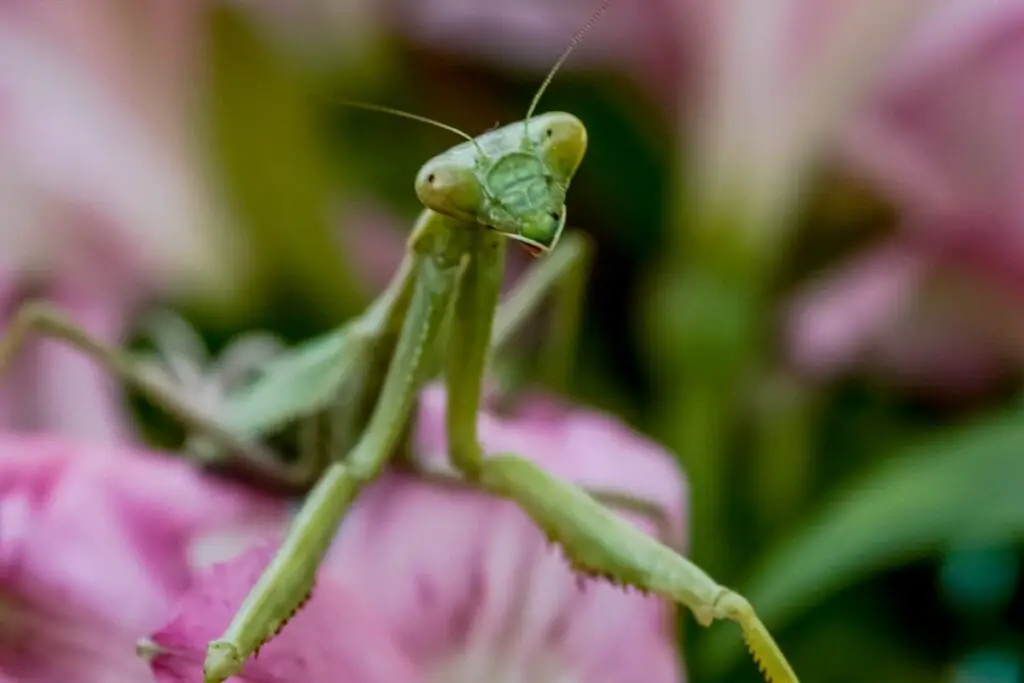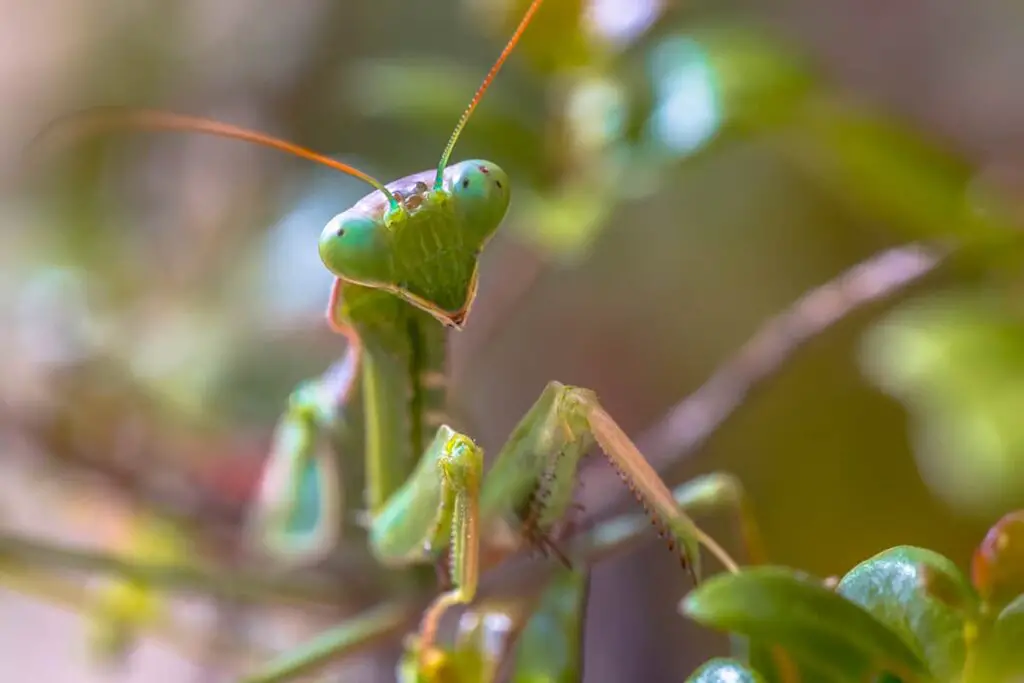When it comes to caring for your praying mantis, understanding its feeding requirements is crucial. Your mantis’s voracious appetite makes mealtime fascinating, but you might wonder just how much and how often you should provide food. The frequency and amount can vary depending on the age and species of your mantis, but there are general guidelines that can help keep your predatory pet satisfied and healthy.
As a rule of thumb, young mantises, or nymphs, should eat every day due to their rapid growth, whereas adults generally require feeding less frequently. The amount of food needed can also change based on the size of the mantis; larger prey for larger mantises, smaller insects for the little ones. Paying attention to your mantis’s behavior can give you clues about its hunger levels, with an active search for prey often indicating it’s time to eat.
Feeding your mantis a variety of live insects not only meets its nutritional needs but also provides mental stimulation and the necessary hunting practice. Offering an appropriate-sized insect for your mantis ensures it gets the right amount of food without unnecessary stress or risk of injury. Remember to remove any uneaten prey to maintain a clean and safe environment for your mantis.
Understanding Mantis Feeding Requirements
To keep your mantis healthy, understanding their specific feeding needs is essential. This involves considering their species and life stage for optimal nutrition.
Species-Specific Dietary Needs
Your mantis’s dietary preferences can vary depending on its species. For example, while most mantises have an appetite for live insects such as flies, moths, and bees, some larger species may occasionally eat small amphibians or reptiles. It’s key to research your specific mantis’s species to provide a suitable and nutritious diet.
Life Stage Nutritional Differences
Nymphs (juvenile mantises): They require smaller prey, such as fruit flies, that they can easily catch and consume. Feeding should be frequent, approximately every other day to support their rapid growth.
Adult mantises: These predators can handle larger prey like moths or crickets. Adult mantises benefit from eating 3-6 prey items per week, depending on the size and activity level of the individual mantis. Regular feeding supports their health but avoids overfeeding which can lead to obesity and health issues.
Feeding Frequency Basics
Understanding how often to feed your praying mantis is crucial for its health and growth. Feeding schedules vary with age and species, so let’s break down the essentials.
Guidelines for Young Mantises
When your mantis is in its early developmental stages, known as the nymph stages, it requires more frequent feedings. Young mantises should be fed every day or every other day. This frequent feeding supports their rapid growth and ensures they molt properly. For instance, an L4 stage Giant Asian Mantis benefits from daily feedings of suitable insects like fruit flies.
Feeding Adult Mantids
As they reach adulthood, the feeding frequency for mantids can be reduced. Adult praying mantises typically need to eat every 2 to 4 days. The size of the prey and the specific needs of your mantis species influence this schedule. For example, an adult praying mantis can consume up to 6 insects a day, but this doesn’t mean daily feeding is necessary or healthy for every individual.
Types of Prey for Mantises
When feeding your mantis, offering a variety of prey can ensure a balanced diet.
Common Prey Choices
Your mantis will thrive on a diet consisting of live insects. The most common prey choices include fruit flies for smaller or young mantises, and larger insects such as crickets, moths, and beetles for adult mantises. Some keepers also provide pollinators like bees, although this is less common.
Sizing Prey Appropriately
It is crucial to size the prey appropriately for your mantis. A good rule of thumb is to offer insects that are no larger than the distance between the mantis’s eyes. Young mantises (<L3 stage) will manage smaller prey such as Drosophila melanogaster (fruit flies), while larger mantises can handle prey as big as Dubia roaches or hornworms.
Monitoring Your Mantis’s Health
Keeping track of your praying mantis’s health includes observing its behavior and physique for signs of good nutrition, as well as knowing when and how to adjust its diet in response to health issues.
Signs of Proper Nutrition
Your mantis should exhibit vibrant colors and an active hunting demeanor when receiving adequate nutrition. A healthy appetite, regular shedding, and a steady growth rate signify that your mantis is well-fed. Be aware that overfeeding can lead to obesity, so if your mantis is looking a bit too robust or refuses food, it could be a sign to cut back.
Adjusting Diet for Health Issues
If your mantis is lethargic or not growing as it should, it might be an indication of a dietary deficiency. In such cases, consider providing a varied diet which may include different types of appropriate insects. Health issues related to nutrition can often be rectified by tweaking the food offered. Make changes gradually and monitor your mantis closely to see how it responds.
Frequently Asked Questions
In caring for your praying mantis, you might have questions about their diet and hydration needs. Below are specific queries answered to help you maintain a healthy mantis.
What varieties of food are suitable for a praying mantis?
Your praying mantis can thrive on a varied diet comprising mostly of live insects, such as fruit flies, crickets, and mealworms. For adult mantises, larger prey like moths or small grasshoppers may be appropriate.
How does the feeding frequency vary for praying mantis nymphs?
Praying mantis nymphs should be fed more frequently than adults, as they require regular nourishment to support their rapid growth. Depending on their size, feeding them every day or every other day is beneficial.
What is the ideal amount of food to give to a Giant Asian mantis?
For a Giant Asian mantis, an average meal may consist of 2-5 large insects such as crickets or roaches, offered every three to four days.
At what intervals do praying mantises require water?
Praying mantises typically get their water from the moisture on leaves and from their prey, but ensuring they have access to small water droplets every 2-3 days is ideal for their hydration.
What are the best feeding practices for young mantis offspring?
Young mantis offspring, or nymphs, benefit from consuming small and soft-bodied insects such as aphids or fruit flies, and they require this suitable prey size more frequently to accommodate their growth.
Is it possible to overfeed a praying mantis, and how can this be avoided?
Yes, it is possible to overfeed a praying mantis. To avoid this, observe your mantis during and after feedings, and reduce the amount and frequency of feeding if you notice a significant bulge in the abdomen or lack of interest in food.
Driven by a passion for those tiny creatures that rule our world, we at Bug Domain strive to be your go-to resource for information on insects.



